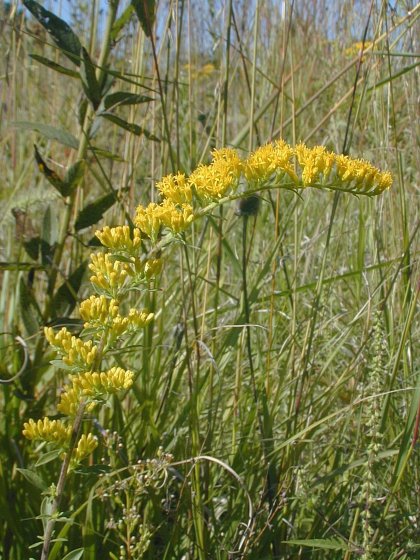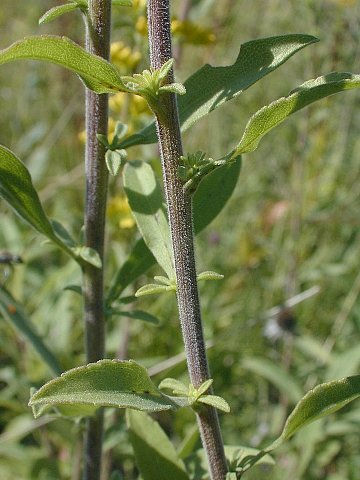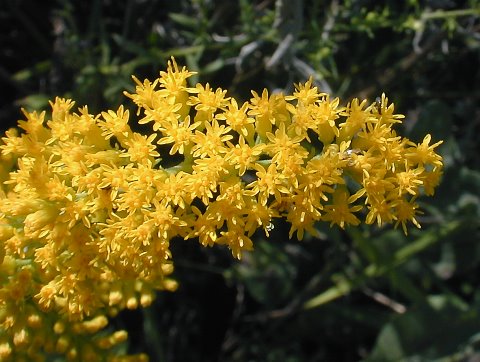Description: This perennial plant is unbranched and about ½-2½' tall. The central stem is reddish or grayish green, terete, and densely covered with short white hairs. The alternate leaves are up to 4" long and ¾" across, becoming smaller as they ascend the stem. They are grayish green, narrowly lanceolate, elliptic, or oblanceolate in shape, tapering gradually to narrow petioles. The leaf margins are smooth (entire) or slightly serrate, while the leaf surfaces are canescent. In addition, there are usually small clusters of secondary leaves that are located along the axils of middle to upper leaves. These secondary leaves are much smaller in size than the alternate leaves, otherwise they are similar in appearance. The central stem terminates in a narrow inflorescence that is shaped like a wand, becoming gradually wider in the middle, and it has a tendency to nod. This inflorescence is typically 3-8" long; it is a narrow panicle of flowerheads with short lateral branches. Each flowerhead is up to ¼" across, consisting of 4-10 ray florets that surround a similar number of disk florets. The petaloid rays of the flowerheads are yellow; the tiny tubular corollas of the disk florets are also yellow. Around the base of each flowerhead, there are scale-like floral bracts (phyllaries) in several series; they are usually pale yellow or pale greenish yellow. The blooming period occurs during the fall and lasts about a month. The flowerheads occasionally have a slight fragrance. After the blooming period, the flowerheads are replaced by achenes that develop tufts of hair; they are dispersed by the wind. The root system consists of a small caudex (at least on older plants) with fibrous roots and rhizomes. At suitable locations, Field Goldenrod has a tendency to form clonal colonies.

Cultivation:
The preference is full sun and dry-mesic to dry soil. Because of
reduced competition, Field Goldenrod thrives best in soil containing
sand, clay or gravel, but it will flourish in fertile soil as well.
This plant is a good choice for difficult locations, such as sunny
slopes or
open areas with poor soil, where little else will grow.
Range & Habitat:
The native Field Goldenrod occurs in most counties of Illinois, where
it is occasional to locally common (see Distribution
Map).
Habitats include upland areas of black soil prairies, gravel prairies,
sand prairies, hill prairies, thinly wooded bluffs, sandy
savannas, sand dunes, fence rows, abandoned fields, eroded clay
banks, roadsides, and areas along railroads. In some western states,
Field Goldenrod is considered a troublesome weed, but in
Illinois it occurs primarily in areas that have little value to
agriculture and ranching. This goldenrod
is found in both degraded and higher quality habitats.

Faunal Associations: A wide variety of insects visit the flowers for pollen and nectar, including long-tongued bees, short-tongued bees, Sphecid and Vespid wasps, flies, butterflies, moths, and beetles. Bee visitors include honey bees, little carpenter bees (Ceratina spp.), Halictid bees, plasterer bees (Colletes spp.), and Andrenid bees. Several Andrenid bees are oligoleges (specialist pollinators) of goldenrods. Fly visitors include Syrphid flies, Tachinid flies, flesh flies, blow flies, and Muscid flies. Other insects feed destructively on the foliage, florets, roots, and other parts of Field Goldenrod and other goldenrods. These insect feeders include Lopidea media (Goldenrod Plant Bug), Corythucha marmorata (Goldenrod Lace Bug), Hesperotettix viridis (Meadow Purple-Striped Grasshopper) and Melanoplus confusus (Little Pasture Grasshopper), the leaf beetles Longitarsus solidaginis and Ophraella sexvititta, the aphids Acuticauda solidaginifoliae and Uroleucon rudbeckiae, and Manomera blatchleyi (Blatchley's Walkingstick). In addition, the larvae of many moths feed on various parts of goldenrods (see Moth Table). Goldenrods are sources of food to some vertebrate animals. For example, the seeds, flowerheads, and leaves are eaten by the Greater Prairie Chicken and possibly other upland gamebirds; the Eastern Goldfinch also eats the seeds. Mammalian herbivores, such as groundhogs, rabbits, deer, and livestock, will browse on Field Goldenrod and other goldenrods occasionally, although they are not preferred as sources of food.

Photographic
Location:
The photographs were taken at a prairie of Parkland College in
Champaign, Illinois.
Comments:
This small goldenrod blooms later than most
goldenrods. Field Goldenrod
can be distinguished from other goldenrods that occur
in Illinois
prairies and other open areas by the presence of secondary leaflets
along the central stem and the presence of short fine hairs on both the
leaves and central stem. In addition, the inflorescence is usually more
narrow and wand-like than those of other goldenrods.